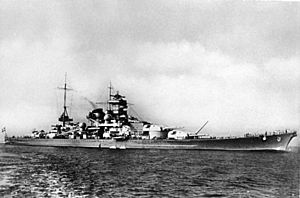Convoy JW 55B facts for kids
Imagine a group of ships sailing through icy, dangerous waters during World War II. This was a "convoy," and its job was to deliver important supplies. Convoy JW 55B was one of these convoys. It sailed from Great Britain in late 1943. Its mission was to help the Soviet Union by bringing them supplies.
All 19 merchant ships in Convoy JW 55B made it safely to the Soviet ports. This was a big success! However, during the journey, a powerful German warship called the Scharnhorst tried to attack the convoy. Luckily, it never reached the convoy. Instead, the Scharnhorst was sunk by British and Norwegian warships in a famous battle called the Battle of the North Cape. The main British ship involved was the battleship HMS Duke of York (17).
Contents
What Was Convoy JW 55B?
Convoy JW 55B was a group of 19 merchant ships. These ships carried vital supplies for the Soviet Union. They left a place called Loch Ewe in Scotland on December 20, 1943.
To keep the merchant ships safe, many warships protected them. These included:
- Close Escort: Smaller ships like destroyers and corvettes that stayed very close to the convoy.
- Ocean Escort: More destroyers, led by Onslow, that protected the convoy across the open sea.
- Cruiser Cover Force: Stronger warships like the cruisers HMS Belfast, HMS Norfolk, and HMS Sheffield. They were ready to fight off any big enemy ships.
- Distant Cover Force: The most powerful group, including the battleship HMS Duke of York (17), the cruiser HMS Jamaica, and four destroyers. This force was led by Admiral Bruce Fraser. They were prepared to stop any major German attack.
The German navy also had plans. They had 13 U-boats (submarines) waiting in the Norwegian Sea. They also had a powerful surface force at Altenfjord in Norway. This force included the battleship Scharnhorst and five destroyers.
The Journey and the Battle
The convoy started its journey on December 20, 1943. Two days later, on December 22, German aircraft spotted the convoy. They kept tracking it, sending updates to the German warships.
On December 25, Christmas Day, a German U-boat called U-601 saw the convoy. Soon after, Admiral Bey, who commanded the Scharnhorst, got permission to attack. Another U-boat, U-716, even got close enough to fire at one of the escort ships.
Admiral Fraser, leading the British distant cover force, was worried. He thought the German Scharnhorst might reach the convoy before his powerful ships could. So, he ordered the convoy to slow down. This helped his ships catch up.
The Scharnhorst never found Convoy JW 55B. Instead, on December 26, it ran into the British cruisers first. Then, Admiral Fraser's heavy ships, including the Duke of York, joined the fight. This became known as the Battle of the North Cape. The Scharnhorst was hit only twice, causing minor damage to the Duke of York and the destroyer Saumarez. But in the end, the Scharnhorst was sunk.
After this big battle, the German U-boats lost track of Convoy JW 55B. No more attacks happened.
On December 28, Soviet warships met the convoy. The ships arrived safely at Kola in the Soviet Union on December 30, 1943.
Why This Convoy Was Important
All 19 merchant ships of Convoy JW 55B reached their destination without any losses. This was a huge success for the Allies.
More importantly, the German navy lost its last major warship in Norway, the Scharnhorst. After this, the German battleship Tirpitz was the only other big German ship left in Norway. But it was not ready for battle for a while. This meant that Allied convoys sailing to the Arctic were much safer from German surface ships for a long time.
Ships Involved
Many ships from different countries helped with Convoy JW 55B.
Allied Ships
- Merchant Ships: 19 ships from the United States, Great Britain, and Panama carried supplies.
- British Royal Navy:
- Battleship: HMS Duke of York (17)
- Cruisers: HMS Belfast, HMS Norfolk, HMS Sheffield, HMS Jamaica
- Destroyers: HMS Onslow, HMS Impulsive, HMS Onslaught (G04), HMS Opportune, HMS Orwell, HMS Saumarez, HMS Savage, HMS Scorpion, HMS Scourge, HMS Virago, HMS Whitehall, HMS Wrestler, HMS Matchless, HMS Musketeer
- Corvettes: HMS Honeysuckle, HMS Oxlip, HMS Wallflower, HMS Borage
- Minesweepers: HMS Gleaner, HMS Halcyon, HMS Hound, HMS Hussar, HMS Hydra
- Royal Canadian Navy:
- Destroyers: HMCS Haida, HMCS Huron, HMCS Iroquois
- Royal Norwegian Navy:
- Destroyer: HNoMS Stord
Axis Ships
|
German U-boat Force
|
German Surface Force
|


